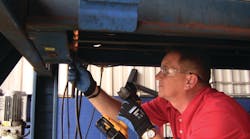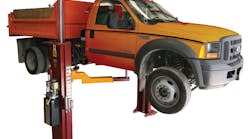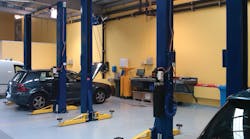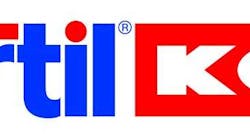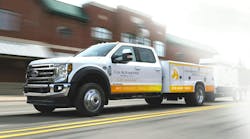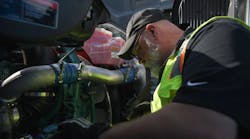There’s more riding on your vehicle lifts than cars and trucks. If you’re the technician who relies on a lift to get your job done every day, your safety is riding on it. If you’re the shop owner whose livelihood depends on your technicians’ safety and performance, your business is riding on it. With so much riding on your lifts, it is crucial that they are properly maintained and inspected regularly to ensure proper performance.
In fact, there is an entire American National Standard outlining the safety requirements for proper vehicle lift operation, inspection and maintenance. This standard, ANSI/ALI ALOIM (current edition), covers lift operator qualifications, training and responsibilities; maintenance procedures, documentation, and frequency; and periodic qualified lift inspection.
In addition to regular in-house inspections, the standard requires that all vehicle lifts be inspected at least annually by a “qualified lift inspector.” A lift inspection is a thorough evaluation of the operating mechanism(s), safety system(s), maintenance, structural integrity, and field modifications of a particular lift in order to identify any risks which may affect the ability of that lift to operate in a safe and reliable manner.
So what is a “qualified lift inspector,” how do you find one, and what takes place during a lift inspection? To get the answers to these questions, we turned to representatives and members of the Automotive Lift Institute (ALI), a trade association of North American-based vehicle lift manufacturers. ALI’s mission is to promote the safe design, construction, installation, service, inspection and use of vehicle lifts.
“When buying a vehicle lift, you are making an investment,” explains Radu Pop, market research analyst for lift manufacturer MAHA USA. “Regular inspection and maintenance is the best way to maximize ROI and to extend the life of the vehicle lift. A properly operating vehicle lift not only makes the mechanic’s job easier, it will also improve performance, revenue and, foremost, safety.”
From “Qualified” to “Certified”
For some shop owners, finding a qualified lift inspector to inspect their lifts has been a challenge. Although the ANSI Standard outlines some lift inspector qualifications, for many years there was no national resource for finding qualified inspectors. In this buyer-beware environment, the best option lift owners had was to get recommendations from the manufacturers of their lifts. That all changed with the launch of the Automotive Lift Institute Lift Inspector Certification Program in October 2012.
“OSHA and other health and safety officers have really stepped up enforcement of lift safety and inspection standards in recent years, leading to growing demand for qualified lift inspectors,” says R.W. “Bob” O’Gorman, ALI president. “In response, ALI invested several years and more than $700,000 to develop the ALI Lift Inspector Certification Program. This program is the first in North America to independently test and certify vehicle lift inspectors. As a result, when lift owners hire an ALI Certified Lift Inspector, they have third-party assurance that the inspector has been proven competent to thoroughly inspect any vehicle lift.”
The ALI Lift Inspector Certification Program is an extension of the association’s other safety-related undertakings, including lift standards development, its third-party lift certification program, and the development of safety and training materials for the industry.
The first group of lift inspectors to achieve certification was announced in May 2013. To find a local company with Certified Lift Inspectors on staff, visit ALI’s online database at www.autolift.org/certified-inspectors.php. The database is searchable by zip code and will be continuously updated as additional inspectors achieve certification.
“The Inspector Certification Program provides the end user with confidence that the inspection completed on their lifts is complete and thorough,” says Todd Michalski, vice president sales and marketing for lift manufacturer Gray Manufacturing Co., Inc. “There are a lot of companies in the market that currently inspect lifts that may or may not have the expertise needed. This helps the marketplace easily identify those that do!”
Becoming certified requires commitment. Candidates must attend an orientation workshop, study the candidate handbook and pass a pre-course exam; study extensive course training materials and pass the course examination; perform 12 practical experience (i.e., real world) lift inspections using approved forms, and submit appropriate paperwork. The inspection company also must establish quality assurance procedures and successfully complete an Initial Compliance Audit of this system. After certification is achieved, participation in continuing education webinars and quality audits is required to maintain Certified Lift Inspector status.
The end result is a pool of lift inspectors that shop owners can trust.
“The ALI Lift Inspector Certification Program provides peace of mind to shop owners, reduces accidents and improves employee confidence in their equipment,” says Harold Yeo, president of lift manufacturer Total Lifting Solutions. “Ultimately this should result in increased throughput of vehicles being serviced.”
Inspection Points
What are Certified Lift Inspectors looking for when examining car and truck lifts? The ANSI standard provides five pages of inspection points, including:
- Examining all accessible structural components, including welds, for any evidence of overloading, misuse or abuse.
- Examining electrical components and wiring.
- Checking the lift controls to ensure accessibility, an unobstructed view of the lift and an automatic return to the neutral or off position when released.
- Locating appropriate lift documentation, safety instructions, vehicle lifting information, lift safety labeling and capacity labeling.
- Confirming adequate clearances around the lift.
- Checking all fastening devices for tightness and proper fit.
- Checking the lowering speed over the full down travel of the lift.
- Operating the lift through its full cycle and checking the operation of the positive stop. Checking to see if the lift locks engage in the fully extended position.
- Checking all lubrication points for cleanliness, integrity of fitting and presence of lubricant.
- Checking all chains and cables for excessive slack.
- Checking all potential pinch points.
The standard is just the starting point. Every lift manufacturer should provide specific directions for inspecting each of its lifts. ALI Certified Lift Inspectors are qualified to inspect any brand or model of vehicle lift.
“During the inspection, the inspector is looking to confirm that all of the lift’s components are in place and in working order,” explains Bob Ford, customer service manager for Rotary Lift. “The inspector is looking at more than just the lift, though. The inspector will survey the lift bay and shop to look for any potential hazards. He or she might make recommendations for other areas of the shop, even though the focus is on the lift.”
At the conclusion of the inspection, the lift inspector should provide a written inspection certificate for each lift to the shop owner or manager. This report documents the results of the inspection, including any recommendations for repair. (ALI Certified Lift Inspectors are instructed not to undermine the program integrity by offering to perform any recommended repairs.) Certified Lift Inspectors will apply an ALI Annual Lift Inspection Label to each lift that passes inspection. This label includes the Inspector’s unique identification number and the date, making it easy for code enforcement officials to quickly ascertain when a lift was last inspected successfully. The labels also serve as a convenient reminder of when a lift is due for its annual inspection.
Safety Starts with You
In addition to annual lift inspections conducted by qualified lift inspectors, most lift manufacturers recommend that lift operators themselves inspect their lifts on a more frequent basis. Recommendations vary from daily to monthly to quarterly, depending on lift style, frequency of use and environment. Check the owner’s manual for the manufacturer’s recommendations.
“It is essential to inspect vehicle lifts regularly for three principle reasons,” sums up Keith Bunn, service manager for lift manufacturer Stertil-Koni. “First, to make absolutely certain that the lift is functioning within its safe design limits. Second, to preserve and protect the longevity of the equipment. And third, to maximize the service life of the equipment and minimize the possibility of facility downtime.”
